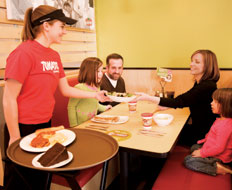At McAlister’s Deli, employees greet customers as they approach the counter to place their order and once more as they deliver meals to customers in the dining room. These same employees also walk the dining room, offering to get drink refills, removing meal debris, and assisting with additional needs as they arise. It’s a full-service restaurant approach in a quick-service operation, one that’s paying dividends for many quick serves both in terms of great customer service and boosting the bottom line.
Mike Watson, executive director of operations engineering for WD Partners, an international design and program management partner for multiunit retail and foodservice brands, says this quasi-table-service approach is a matter of prioritizing how the customer in the dining room is treated.
“It’s a liaison between the brand and the customer,” he says. “It can really expand what the brand means and what the brand is.”
This certainly played a role in the decision to employ dining-room associates—employees referred to as “mayors”—at Stevi B’s Pizza Buffet locations. Company president Matthew Loney says the idea evolved during an internal brainstorming session to rebrand the company as a premium pizza buffet. “It’s a way to give the type of experience and service you wouldn’t expect at a buffet,” he says.
For Fazoli’s, dining-room employees, who bring breadstick refills out to customers and deliver food orders, are a point of comparison of service to other quick-service restaurants.
“We look at it from an added-value standpoint,” says Cathy Hull, chief marketing officer for Fazoli’s. “You have to look for ways to stand out, because quick-serve has become so price-driven. You are duking it out with your neighbor.”
Measuring the effectiveness of dining-room employees, however, can prove difficult if operators are looking for hard numbers. “It’s a soft return that you cannot quantify on the bottom line,” Watson says. “[But your] sales won’t struggle as much during the tough times because there’s a relationship between the customer and your business.”
In 2009, the company found that the execution on five service touch points—friendly and knowledgeable order taker, friendly and helpful server, employee offered a drink refill, customer received appropriate extras, and manager was visible—drove guest satisfaction higher.
When all five touch points were executed, overall customer satisfaction was more than 80 percent—giving customers reason to return. McAlister’s data shows that on a systemwide basis, restaurants with the highest “likelihood to return” scores show a 1.9 percent increase above average sales growth, while those with the lowest scores reflect a drop of 1.8 percent below average sales growth.
Since it’s hard to quantify long-term results, many operators are wary of spending labor costs up front to implement a dining-room service program. But Phil Friedman, CEO of McAlister’s, cautions these operators to look beyond the cost.
“This is an investment in your guest and his or her frequency versus the cost,” he says. “You’re really looking at driving frequency and improving loyalty.”
When hiring employees to work the dining room, the overwhelming consensus is to hire someone with the right personality who can engage the customers.
“Don’t just take people hired for the counter and send them out,” Friedman says. “Hire for that position, guest engagement. Make a job description and train so it’s part of your concept, not just someone sent out to be there.”
Having the right person in place ensures this service aspect is done right. “It comes down to execution,” says Richard Stoll, cofounder of Georgia-based fast casual Cheeseburger Bobby’s, where employees refill customers’ french fries, pass out mints, and offer custard tastings. “If we don’t execute it properly, it just doesn’t matter.”
Loney recommends hiring for this position from within. “This person needs to know your brand and carry themselves well and talk knowledgeably about the product,” he says.
Dining-room employees should also have the leeway to address customer needs. “Empowering people is where you start to make a difference,” says Bennett Kopp, owner and operator of a Charley’s Grilled Subs franchise in Knoxville, Tennessee. Employees at Charley’s Grilled Subs carry food to the table for customers with infants or those on crutches, and also offer drink refills or cookies for special occasions. “[Employees] will make mistakes, but they will become professional operators. Make them a part of your business.”
Watson says quick-serve operators need to make sure their dining-room service plan is well-defined so all employees know what is expected on their behalf, as well as what the customer can expect during repeat visits.
“Don’t try to roll something out in a bunch of stores until you know what it’s going to look like,” Watson says. “Pick a store, and build a model of what you want it to be. You can influence the customer in a number of ways, and you have to know how it’s going to impact the customer.”
During this building phase, operators recommend experimenting with scheduling, the number of employees working the dining room at a given time, and the responsibilities these employees would have. “Be strategic about when these people are working,” Loney says. “Test it during your busiest times. Talk with customers for feedback. See if it increases traffic.”
Hull suggests waiting at least 30 days to test the effectiveness of a dining-room service program, and then tweak its imperfections. “Do an analysis to see if it’s right for your operation,” she says. “Continue to look at it over the next 90 days, and then see what the next step is.” Ultimately, if you are going to do it, commit to it, Friedman says. The actions, or inactions, of a dining-room employee have an effect on your consumers.
“It’s got to come from the heart,” Cheeseburger Bobby’s Stoll says. “You can fake it for a while, but if you don’t enjoy pleasing your guest, then you won’t follow through with it.”











